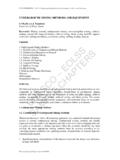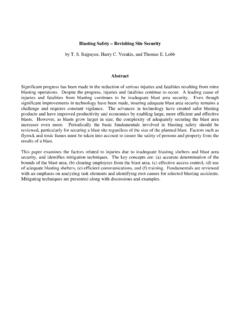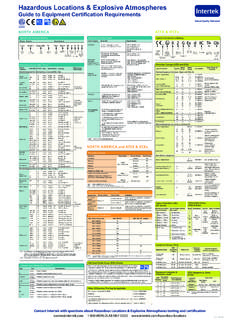Transcription of Underground Coal Mine Disasters 1900 - 2010: Events ...
1 1 Underground Coal Mine Disasters 1900 - 2010: Events , Responses, and a Look to the Future Michael J. Brnich, Jr., BS, CMSP NIOSH Office of Mine Safety and Health Pittsburgh, PA, USA Kathleen M. Kowalski-Trakofker, NIOSH Office of Mine Safety and Health Pittsburgh, PA, USA ABSTRACT: This paper captures almost 110 years of history of Underground coal mine Disasters in the United States. The deadly Disasters of the first ten years of the twentieth century led to the Congress founding the Bureau of mines (USBM) in 1910. The authors examine the changing trends in mine Disasters including the frequency of fatalities, causal types, the responses to those Disasters and most importantly, the growing body of research on human behavior in mine emergencies. Emphasis is on the future - integrating the research on human behavior in Disasters into the mining industry. This research includes the integration of the judgment decision-making process, communication, leadership in escape, expectations training, incident command center issues including fatigue, shifts and leadership, plus issues concerning the introduction of refuge chambers into mines .
2 The authors suggest that a key factor in meeting the goal of increasing successful mine escape and rescue while decreasing fatalities and injuries lies in the field of social-psychological research and human behavior interventions. INTRODUCTION Mine Disasters have been a focal point among mine operators, safety and health personnel, and miners, as well as mine safety and health researchers in the United States for decades. Hundreds of Disasters , resulting in thousands of mine worker deaths, have occurred in mines since 1900. Because most of these catastrophes have occurred in Underground coal mines , the authors have chosen to focus on these Disasters in this paper. The authors examine and discuss the history of coal mine Disasters in the with emphasis on changing trends in Disasters , responses to the Disasters , the growing body of research on human behavior in mine emergencies, and implications for future integration of research on human behavior into the mining industry.
3 The Mine Safety and Health Administration (MSHA) classifies Disasters by number of fatalities and by cause. MSHA defines a " disaster " as an incident with five or more fatalities. In this paper, the authors do not differentiate incident from disaster , and discuss incidents with too few fatalities to be classified as " Disasters " by MSHA. Causes are grouped into six categories: 1) explosion; 2) fire; 3) haulage (transportation of personnel, materials, or equipment ); 4) ground fall/bump (fall of roof rock or an outward, violent burst of a pillar); 5) inundation (the sudden inrush of water or toxic gases from old workings); and 6) other (MSHA 2006a). From 1900 2006, 11,606 Underground coal mine workers died in 513 Underground coal mining Disasters , with most Disasters resulting from explosions (Kowalski-Trakofler, et al.,2009a). In 2007, 9 additional workers died in the Crandall Canyon disaster (Gates, et al. 2007a), bringing the total to 11,615 miners killed in 514 Disasters .
4 Table 1 summarizes the number of Disasters by category and the related number of fatalities for the period. Table 1. Number of Underground coal mine worker fatalities by type of disaster , 1900 through 2008 Type incident Number of Events Number of Fatalities Explosion 420 10,390 Fire 35 727 Haulage 21 145 Ground fall/Bump 14 92 Inundation 7 62 Other 17 199 2 The major coal mine Disasters are presented within three time periods: 1900 1909, preceding the founding of the Bureau of mines ; 1910 1969, a period of significant decrease in Underground coal mine Disasters ; and 1970 present, a period when human behavior and psycho-social factors came into play. Industry and congressional responses to these Events are also presented in these timeframes. THE Events : MAJOR COAL MINE Disasters The period 1900 through 1909 The period 1900 through 1909 was the deadliest decade in Underground coal mining , and led to the legislation that founded the Bureau of mines with the express mandate of reducing fatalities in the mining industry.
5 From 1900 through 1909, 3,660 miners perished in a total of 133 mine Disasters . Sixteen major mine Disasters during this time period killed 2,070 miners. These 16 Events are summarized in Table 2. Table 2. Major Underground coal mine Disasters , 1900-1909 Year Mine Type disaster No. Killed 1902 Fraterville Explosion 184 1902 Rolling Mill Explosion 112 1903 Hanna No. 1 Explosion 169 1904 Harwick Explosion 117 1905 Virginia City Explosion 112 1907 Stuart Explosion 84 1907* Naomi Explosion 34 1907* Monongah Nos. 6 & 8 Explosion 362 1907* Yolande Explosion 57 1907* Darr Explosion 239 1907* Bernal Explosion 11 1908 Hanna No. 1 Explosion 59 1908 Rachel and Agnes Explosion 154 1908 Lick Branch Explosion 50 1909 Lick Branch Explosion 67 1909 Cherry Fire 259 *Occurred in December, 1907 December 1907, known as Bloody December , is the deadliest on record for the Underground coal mining industry. That month 703 miners died in 5 mine explosions. The Monongah Nos. 6 & 8 disaster , the Darr disaster , and the Cherry disaster remain 3 of the deadliest Events in coal mines .
6 The period 1910 through 1969 After the founding of the Bureau of mines , a number of major Events were still to come. Many of the Events lead to changes in mine safety and health regulations. Overall, 1910-1969 was a period of significant decrease in Disasters . Stag Canyon No. 2 Mine - 1913 An October 1913 explosion rocked the Stag Canyon No. 2 mine in New Mexico, killing 263 workers in the mine. Fourteen miners escaped from an unaffected part of the mine; 9 others were rescued from the bottom of the air shaft. The explosion was caused by detonating an overcharged shot in a dusty pillar section (MSHA, 1998a). Eccles Nos. 5 and 6 mines - 1914 A methane explosion occurred in April 1914 at the Eccles Nos. 5 and 6 mines in West Virginia. There were 246 miners working when the explosion occurred. All 172 miners working in the No. 5 Mine were killed. Afterdamp 3 killed 8 miners in the No. 6 mine, working in the coal seam above. Sixty-six miners escaped from the No. 6 mine (Ibid).
7 Castle Gate No. 2 Mine - 1924 A series of three explosions struck the Castle Gate No. 2 mine in Colorado in March 1924. The disaster claimed the lives of 172 workers. The initial explosion occurred when a mine examiner attempted to relight his key-locked safety lamp from his carbide cap lamp and ignited methane (Ibid). Mather No. 1 Mine - 1928 An explosion in May 1928 at the Mather No. 1 mine in Pennsylvania killed 195 of the 279 workers Underground . Methane accumulated in a working section, possibly caused by an open mandoor. The gas was ignited by an arc from a battery locomotive working in the area (Ibid). After the Mather mine explosion, there were no major mine Disasters for 12 years, until 226 miners died in three major Disasters between January and July 1940. Two other major Disasters , in 1942 and 1943, killed 130 miners (Ibid). Centralia Mine - 1947 An explosion in the Centralia No. 5 mine in Illinois killed 111 miners. Eight miners were rescued and 24 managed to escape after the explosion.
8 The disaster is believed to have been caused by either an insufficiently charged shot or a blown-out shot stemmed with coal dust (Ibid). Orient No. 2 Mine - 1951 An explosion in December 1951 at the Orient No. 2 mine in Illinois killed 119 of the 256 miners working Underground . A main ventilation door was left open, relieving the ventilation pressure on old abandoned panels. It is believed methane came out of abandoned panels and traveled to an active section where it ignited, possibly due to an arc from electrical equipment (Ibid). Farmington No. 9 - 1968 The frequency and severity of Underground coal mine Disasters continued to decline in the 1950s and 1960s. Many mine safety practitioners believed the day of major Disasters had come to an end, until a major explosion tore through the Farmington No. 9 mine in West Virginia on November 20, 1968. At the time of the explosion, 99 miners were working Underground ; only 21 managed to escape. With no hope of finding survivors, the mine was sealed on November 30, 1968 (MSHA 1989).
9 The mine was recovered and between September 1969 and April 1978, the bodies of 59 victims were removed. The mine was permanently sealed in November 1978, leaving 19 victims entombed. The cause of the explosion was never determined. However, the event would have far reaching effects that would forever shape mine safety and health (MSHA 1998a). The period 1970 through 2008 While the frequency and severity of Underground coal mining Disasters along with the number of miner deaths decreased substantially during 1970 2005, several significant Disasters did occur that had further impact on mine safety and health in the Before 2005, the total number of mining Disasters had decreased from a high of 20 in 1909 to an average of one every 4 years during 1985 2005 (Kowalski-Trakofler, et al. 2009a). However in 2006, Disasters at the Sago mine in West Virginia and the Darby mine in Kentucky claimed a total of 17 lives. The 2007 Crandall Canyon disaster killed 9 workers. No mine Disasters occurred in 2008.
10 Scotia Mine - 1976 In March 1976, two explosions occurred on separate days at the Scotia Mine in Kentucky. The first occurred on March 9, killing 15 of the 116 miners working Underground . The second explosion took place on March 11, during recovery operations. It killed 11 of 13 workers Underground , including several inspectors. Investigators believed the first explosion occurred when an accumulation of methane in a track entry was ignited by arcing created in the controller of a locomotive. The second explosion is also believed to have occurred when methane was ignited by an arc from electrical equipment (MSHA 1998b). Following the Scotia mine disaster , a handful of other Disasters occurred in the Table 3 summarizes these Events . 4 Table 3. Underground coal mine Disasters , 1977-1999 Year Mine Type disaster No. Killed 1977 Porter Tunnel Inundation 9 1980 Ferrell No. 17 Explosion 5 1981 Dutch Creek No. 1 Explosion 15 1981 Adkins Coal No. 11 Explosion 8 1981 Grundy mining No.














